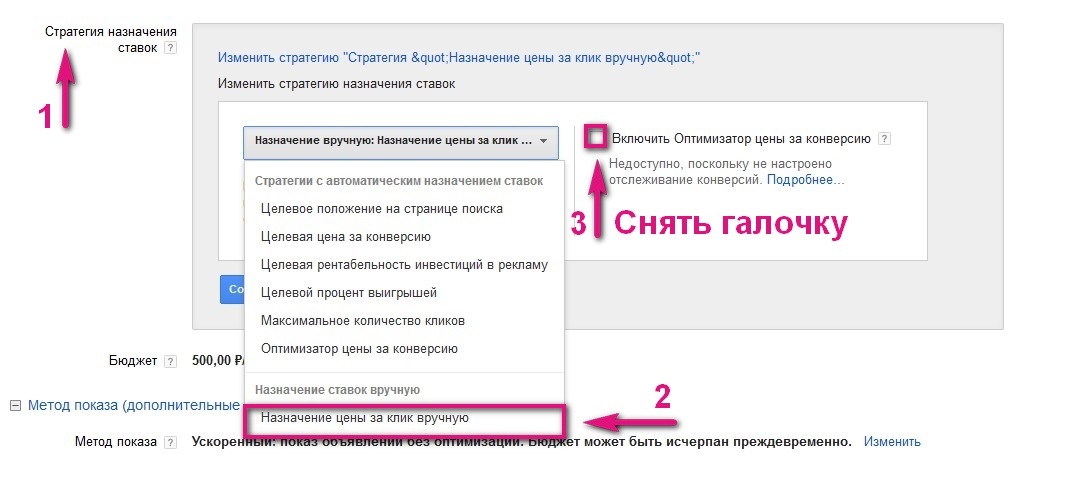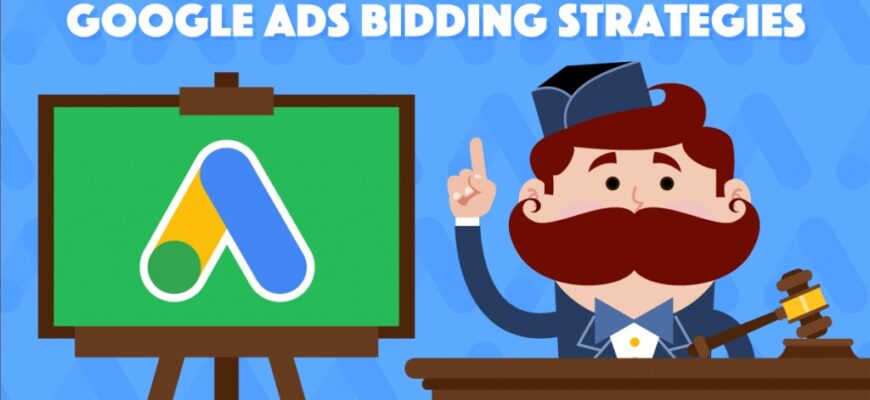- What to consider when choosing a bidding strategy in Google Ads?
- Manual bid management in Google AdWords
- Automatically setting bids in Google Ads
- Target Price Per Conversion
- Target return on advertising investment
- Maximize conversions
- Price-per-conversion optimizer
- Maximum number of clicks
- Target position on the search page
- Target winning percentage
- Target percentage of impressions received
- What strategy to choose in AdWords?
- How to use aggressive rate management?
Choosing the right bidding strategy in Google Ads is guaranteed to help you reduce your ad spend. However, this task is not as easy as it may seem.
The fact is that with AdWords there are as many as eight automatic strategies for setting the cost of transition and one manual one. This article will help the user to choose the most appropriate one to use in a particular situation.
What to consider when choosing a bidding strategy in Google Ads?
Determining the most effective bid assignment method is done when you initially launch and configure campaign settings in Google AdWords. Take into account the following aspects:
How many calls and sales will I get by ordering contextual advertising from you?
I need to calculate the conversion of my website Describe
the task
in the application
Calculate potential ad revenue Google
contextual advertising calculator
- Bid detection in manual or auto mode. Automation allows you to avoid fiddling with settings. It is convenient and not time-consuming, even when we are talking about an account with dozens and sometimes hundreds of active campaigns. The disadvantage of this option is that the system completely controls the entire process. Strategies with manual settings give greater freedom of account management. All parameters can be set and edited by the advertiser at any time. But this requires a significant investment of time. This method should not be used without sufficient experience with Google Edwards. Beginners are usually recommended to use the automatic selection of bid;
- Campaign goal. It is necessary to understand what goal you want to achieve when setting up advertising – to increase reach, to get conversions to the site, to raise the number of orders. Each of the goals corresponds to its own algorithm for setting bids in Google Ads, which is better to use in this or that case.
Manual bid management in Google AdWords

Google AdWords manual bidding strategy gives you a high degree of control over your account settings. It is indispensable if you understand which key phrases are most effective and where your ads should be located. You can set the maximum cost per click for each keyword and for the list of ads. Management is extremely simple – if the position is not high enough, you just need to increase the price per click.
The advantages of manual management include full control over the parameters of the RC. The main disadvantages are significant time spent on adjustments and analytics, as well as the need to have sufficient experience with the advertising cabinet.
When the “Conversion Price Optimizer” is enabled as part of manual control, the system can increase the bid within the limits set by the advertiser, if the probability of conversion is high, and reduce it when this probability decreases.
The principle by which bids are set manually when launching a new RC is as follows:
- The highest ones are set for queries with the highest potential;
- To achieve a high quality score, the bid at the start should be one-third higher than Google’s suggested bid. Otherwise, the quality score will drop to 2-3 and considerable effort will be required to improve it;
- Next, you need to determine the relationship between the position of the ad on the page, and the cost of a click;
- When stable results are obtained, the amount of the cost of a click can be gradually adjusted downward.
Automatically setting bids in Google Ads

Automated strategies are a good way to spend budget on achieving specific goals instead of a mass of clicks on ineffective queries. Understanding the algorithms of the system and their scope of use will allow you to spend money with the greatest benefit. There are currently 8 strategies, which will be discussed below.
Target Price Per Conversion
When you use it, Google automatically changes the bid for ads whose display is more likely to result in the required conversion. The algorithm is set up to maximize the number of target actions at the required cost. On average, the final price per action will be close to the set price, but sometimes differs from it more or less. The strategy works most effectively when there are no budget constraints, but the cost of conversion is rigidly fixed.
It is relevant only if a sufficient amount of statistics has been collected in the account before. Then the Google AdWords mechanism will automatically adjust the price indicators.
If you immediately set the desired rates, you increase the risk of losing traffic and, as a consequence, the number of required actions on the site. At the initial stage, you should set the actual price, analyze the advertising campaign for at least two weeks, and only then gradually change the rates to the desired level.
Target return on advertising investment
With this strategy, you can set a ROI limit (often abbreviated ROI) and the system will set the click price to provide the desired ROI.
It is used where there is a need to increase the budget while maintaining the current profitability. Initially, evaluate the performance of the system by specifying a standard ROI. Once the system begins to sustain the desired ROI, you can increase costs.
Maximize conversions
An ideal strategy when you need to increase the number of applications. The only available limitation is the daily budget of the campaign. The price of the conversion itself is not fixed by the advertiser. The system independently sets rates focusing on maximizing the number of orders received within a given budget.
It is not used for general budgets, because the costs and average cost of conversion fluctuate significantly.
Important! It is necessary to control the value of the daily budget, because in this strategy it is used to the maximum. This can lead to increased costs.
How many calls and sales will I get by ordering contextual advertising from you?
I need to calculate the conversion of my website Describe
the task
in the application
Calculate potential ad revenue Google
contextual advertising calculator
Price-per-conversion optimizer
When there is a reasonable forecast of traffic increase, for example, a sale or a sharp seasonal surge in demand, this strategy is more suitable than any other. To have time to train the algorithm, set it up a few days before the anticipated increase in traffic.
There are two display mechanisms: standard and accelerated. The algorithm works effectively if there is no budget deficit and 24-hour display. If the budget for advertising is modest, some users will not see it. After all, as soon as the daily limit is reached, the shows will stop.
Tip! During periods of sharp increase in demand, competition increases significantly, so it is reasonable to raise Google Ads rates for this time.
Maximum number of clicks
It works as follows: the user limits only the daily budget, and the system provides as many clicks as possible within it. The approach is in demand by Internet portals where traffic, not requests, is important. For example, it is suitable for news sites.
The advertiser also has the opportunity to fix the limit of the maximum cost per click, but this setting is not activated by default. In order to enable it, activate the “Conversion Price Optimizer”.
Target position on the search page
If you want your ads to appear on the first page of search results or in the first position above the results, this is an appropriate strategy. But it is not designed for PBC.
The options available to choose from are:
- First place in the advertising results of the search engine;
- Any position on the first page of the search engine results.
Target winning percentage
Allows an advertiser to set the frequency of wins in an auction with a competing domain by limiting the maximum bid size. The system calculates the optimal position of the ad compared to the competitor, but does not ensure presence on the first page.
This unusual and curious strategy is rarely used. It makes sense to use it if the advertiser has a small number of competitors or has the most important competitors from a large list.
Target percentage of impressions received
The mechanism of work is similar to the algorithm “Target position on the search page”, but it is possible to set the required share of impressions in a certain part of the initial page of the search engine, while limiting the maximum size of the bid.
Attention! The most effective work is possible only after a certain time, which is required for the accumulation of statistical data.
What strategy to choose in AdWords?

You should decide which Google Ads strategy to choose based on certain data, not randomly. Take into account not only the goals of the advertising activity, but also the approaches used by competitors.
The “Target position on the search page” and “Target winning percentage” will help to improve recognition. If the task is to attract the largest number of customers, you should use “Maximum clicks”. The highest number of orders on the site can be achieved by using other, more advanced strategic solutions.
Important: The strategy can be changed at any time, but you will have to wait 1-3 weeks to evaluate the results.
Regular analysis of intermediate results allows you to achieve your goals with minimum expenses.
How to use aggressive rate management?
It usually takes some time to see results from an algorithm change. However, there is a way to reduce the waiting time. To do this:
- The bid is fixed at the level that is sufficient for the first position in the issue. Expensive clicks will help to collect more traffic and increase clickability. Within a few weeks, quality scores will improve;
- The next step should be to reduce bids to the level of second place. As a result – a tangible reduction in click costs, while maintaining a high position and performance of the RC.
Tip! Google offers a convenient tool for predicting the cost of placement in the top for a certain query – keyword planner.
















